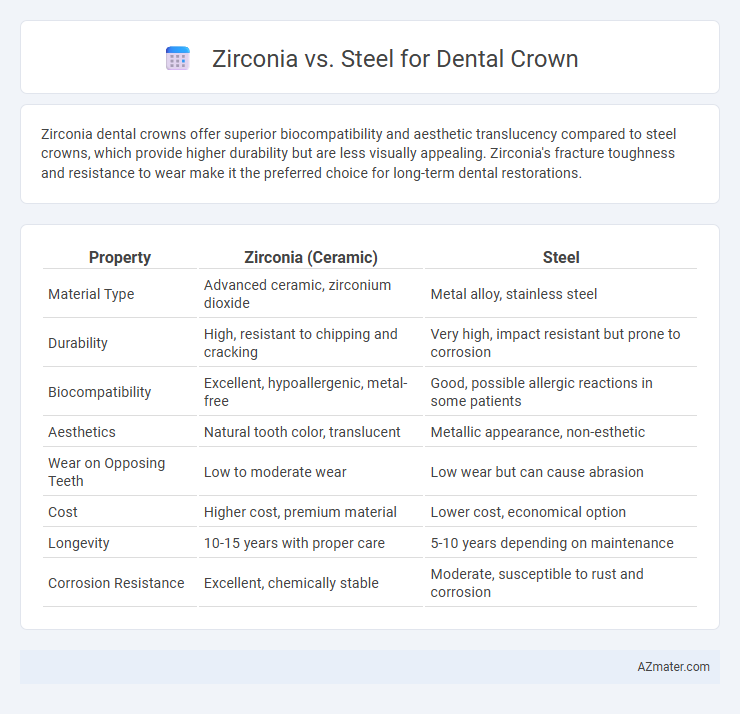Zirconia dental crowns offer superior biocompatibility and aesthetic translucency compared to steel crowns, which provide higher durability but are less visually appealing. Zirconia's fracture toughness and resistance to wear make it the preferred choice for long-term dental restorations.
Table of Comparison
| Property | Zirconia (Ceramic) | Steel |
|---|---|---|
| Material Type | Advanced ceramic, zirconium dioxide | Metal alloy, stainless steel |
| Durability | High, resistant to chipping and cracking | Very high, impact resistant but prone to corrosion |
| Biocompatibility | Excellent, hypoallergenic, metal-free | Good, possible allergic reactions in some patients |
| Aesthetics | Natural tooth color, translucent | Metallic appearance, non-esthetic |
| Wear on Opposing Teeth | Low to moderate wear | Low wear but can cause abrasion |
| Cost | Higher cost, premium material | Lower cost, economical option |
| Longevity | 10-15 years with proper care | 5-10 years depending on maintenance |
| Corrosion Resistance | Excellent, chemically stable | Moderate, susceptible to rust and corrosion |
Introduction to Dental Crowns: Zirconia vs Steel
Dental crowns restore damaged teeth by providing strength and durability, with zirconia and steel being popular material choices. Zirconia crowns offer superior aesthetics and biocompatibility, making them ideal for visible teeth, while steel crowns are known for their cost-effectiveness and robust durability, often used in pediatric dentistry. Comparing zirconia vs steel crowns involves evaluating factors such as strength, appearance, longevity, and patient-specific needs.
Material Composition: Understanding Zirconia and Steel
Zirconia dental crowns are composed primarily of zirconium dioxide, a ceramic material known for its high strength, biocompatibility, and aesthetic translucency, closely mimicking natural tooth enamel. Steel crowns, often made from stainless steel alloys, are metallic and durable but lack the natural appearance and are typically used for temporary restorations or pediatric dentistry. The material composition of zirconia offers superior resistance to wear and corrosion compared to steel, making it a preferred choice for long-term dental restorations.
Strength and Durability: Which Lasts Longer?
Zirconia dental crowns offer superior strength and durability compared to steel crowns, resisting fractures and wear over time. Their biocompatible structure allows them to maintain integrity under heavy biting forces, making them ideal for long-term use. Steel crowns, although strong and cost-effective, tend to corrode and degrade faster, resulting in a shorter lifespan.
Aesthetic Appeal: Natural Look Comparison
Zirconia dental crowns offer superior aesthetic appeal due to their translucent properties that closely mimic the natural enamel of teeth, providing a lifelike appearance ideal for front teeth restorations. Steel crowns, in contrast, lack translucency and exhibit a metallic, opaque finish that is less visually pleasing and typically reserved for temporary or pediatric use. The natural look of zirconia crowns makes them the preferred choice for patients seeking cosmetic dental enhancements with long-lasting durability.
Biocompatibility and Patient Safety
Zirconia dental crowns exhibit superior biocompatibility compared to steel, minimizing the risk of allergic reactions and gum irritation due to their inert, non-metallic composition. Steel crowns can sometimes cause metal sensitivity, leading to inflammation and discomfort in certain patients. For optimal patient safety and long-term oral health, zirconia is preferred as it encourages better tissue response and reduces the likelihood of adverse immune reactions.
Cost Differences: Zirconia vs Steel Crowns
Zirconia dental crowns typically cost between $800 and $2,500 per tooth, reflecting their high durability and natural appearance. Steel crowns, often used as a temporary solution particularly in pediatric dentistry, are substantially less expensive, ranging from $100 to $300 per crown. The significant price difference is influenced by the material quality, longevity, and aesthetic appeal, with zirconia offering superior biocompatibility and metal-free composition compared to steel.
Procedure and Fitting Process
Zirconia dental crowns require digital scanning and CAD/CAM technology for precise design and milling, ensuring a highly accurate fit with minimal adjustments. Steel crowns involve a simpler procedure where the crown is pre-formed, trimmed, and manually fitted, often requiring more chair time for adjustments. The fitting process of zirconia crowns offers superior adaptation to tooth structure and better marginal integrity compared to steel crowns, leading to enhanced durability and patient comfort.
Maintenance and Longevity Considerations
Zirconia crowns exhibit superior durability and resistance to wear compared to steel crowns, significantly reducing the need for frequent replacements or repairs. The biocompatibility and stain resistance of zirconia contribute to easier maintenance and longer-lasting esthetic results. Steel crowns, while durable, may be prone to corrosion and discoloration over time, necessitating more frequent upkeep and potential early replacement.
Suitability for Different Patients and Teeth
Zirconia crowns offer superior biocompatibility and aesthetics, making them ideal for patients with metal allergies or those seeking natural-looking restorations, particularly for front teeth due to their translucency. Steel crowns provide robust durability and affordability, often preferred for pediatric patients and molars where strength outweighs cosmetic concerns. Patient-specific factors like bite force, allergy history, and tooth location critically influence the choice between zirconia and steel dental crowns.
Conclusion: Choosing the Best Crown Material
Zirconia crowns offer superior aesthetics, biocompatibility, and resistance to wear compared to steel crowns, making them ideal for permanent restorations in visible areas. Steel crowns, while durable and cost-effective, are better suited for temporary solutions or pediatric dentistry due to their metallic appearance and lower customization options. Selecting the best crown material depends on patient-specific factors such as durability needs, aesthetic preferences, budget, and the location of the tooth within the mouth.

Infographic: Zirconia vs Steel for Dental crown
 azmater.com
azmater.com